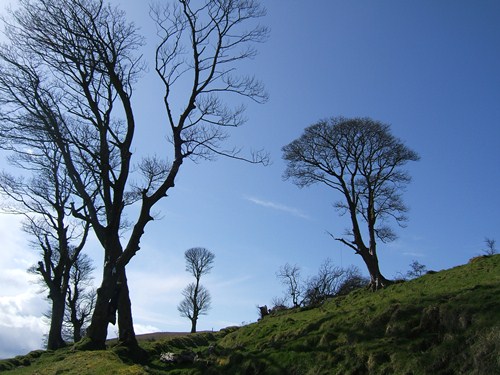(above: Hatchet Field, photo: Ciarán Ó Brolcháin)
In yesterday’s article, Beatrix Campbell interviewed Terry Enright, whose poem Requiem for a Sycamore, pays homage to the small clump of trees that populate the Hatchet Field. The field is unique, its grassland and sycamores contrasting with the bracken and heather of the hillside.
Requiem for a Sycamore
I saw you looking down,
Majestic
Your mighty branches spread,
Like muscles on a giant,
500 thousand leaves, and more,
Love letters carved on your bark
The beauty of the hill
You were my shelter from the sun,
Cover from the rain,
I sat in the silence of winter snow,
A single Wren stared at me,
Wondering
Voices whispering in the wind,
High above everything
War in the streets below,
Spies in the grass,
Watching
Happy children swinging on a single rope,
Flying over Belfast without wings,
Oblivious
To the pain and joy you have seen
Now I sit on your prostrate corpse,
Felled by November storms,
I lament your passing,
Nature, like life itself,
Demands a price, we all must pay,
Still I cherish, the pleasure we have shared,
High up in the Hatchet Field
(above: The fallen trees of Hatchet Field, photos: Liam Barr)
More on Hatchet Field:
In the archive Old Belfast Districts, Ballymurphy resident Joe Graham recalls:
‘Higher up the Black Mountain the strangely shaped “Hatchet Field” can be seen and to this day, even centuries having been so named the distinct hatchet shape of the field can be clearly seen by visitors to any part of Belfast. As a child I would often look out from our bedroom window on the field, curious as to the origin of the shape and name. I wondered did that strangely shaped field hold a dark mystery as to its link with an axe … I stumbled on an article in an old newspaper report … “On February 13th 1753, a cattle drover, William Cole, his daughter Elizabeth and a woman named Mary Maguire, a visitor at the house, were brutally murdered by an axe”. Below the Hatchet Field, in the white lime cliffs, are two caves in which the famous Ness O’Haughan, the Highwayman, is said to have hidden from the redcoats during his time on the run, before he was captured and hanged at The Three Sisters, the Gallows Green, near Carrickfergus Castle. Legend has it that much of Ness O’Haughan’s stolen treasure was never retrieved and is hidden there somewhere on the Divis Mountains.’
About the Poet:
Terry Enright – A community activist from West Belfast, Terry is well-known environmentalist central to the ‘Save the Black Mountain’ anti-quarrying campaign. He is Vice-chair of the Upper Springfield Development Trust, a long-standing trades-union and human rights activist and was community representative on the Equality Coalition and Human Rights Consortium.




Pingback: The hills above Belfast « Under a Grey Sky
I spent many days on the Hatchet Field during my youth. Had the pleasure of walking with Terry on many occasions, aswell as in protest at the distruction of the Black Mountain.
A beautiful poem by Terry Enright, he will be sadly missed just like Terry og who I had the pleasure of hiking in the Mournes with before his untimely death. Two great people gone but not forgotten. Both played active roles in our community and tried their best in difficult times.
Hi Kevin,
Thanks for that. I only heard the news about Terry from my dad last night, and although I never met him, everything I heard about him spoke to a wonderful man. My thoughts are with his family and friends.
Pingback: A Belfast Diary « Under a Grey Sky
Pingback: Above the invisible city – Black Mountain, Belfast | Under a Grey Sky
Pingback: Return to the Black Mountain | Under a Grey Sky